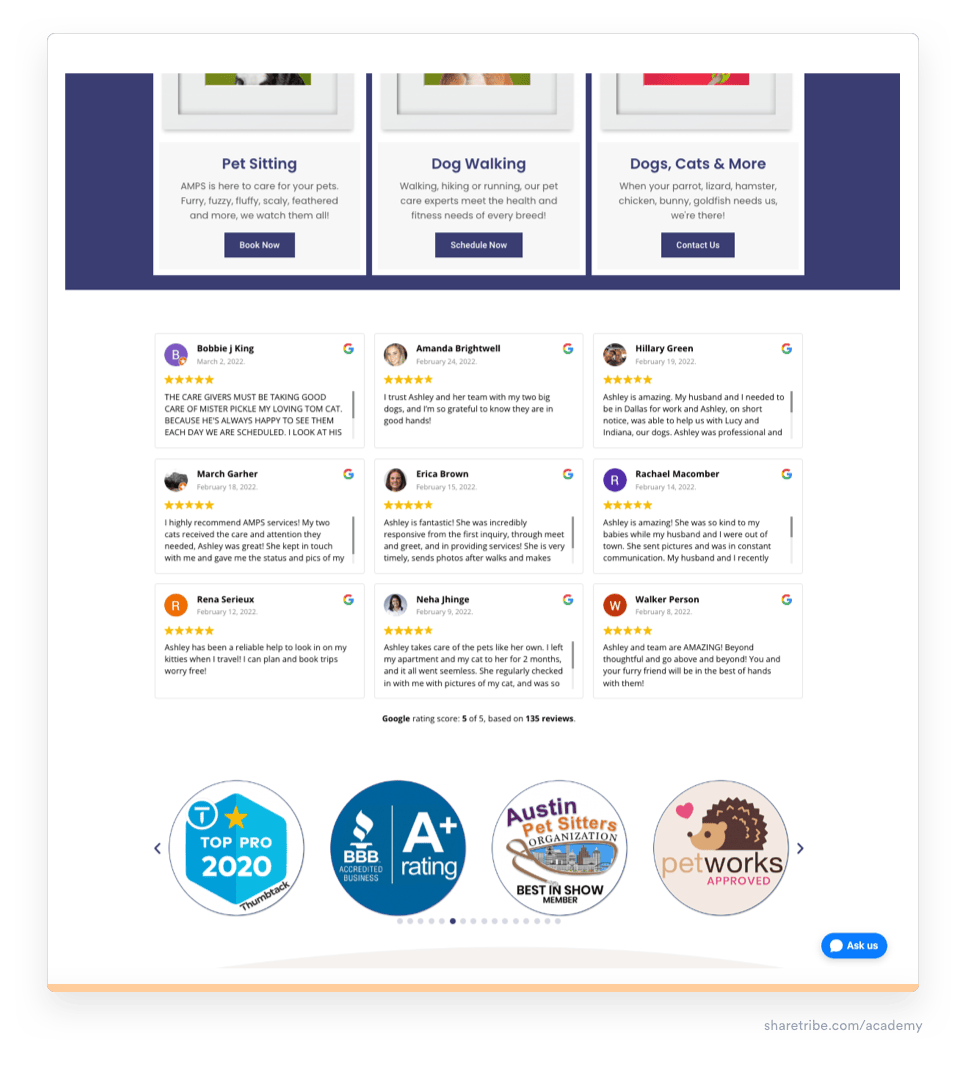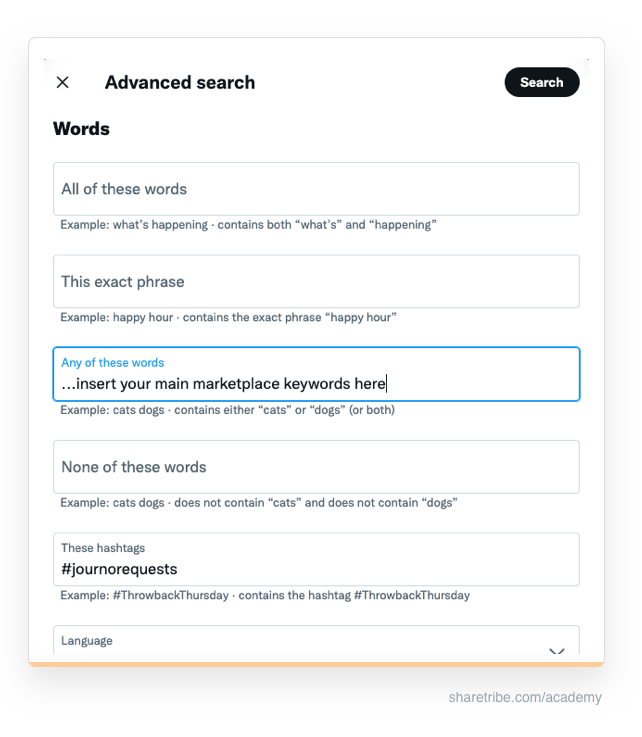Link building for marketplaces
Backlinks are votes of confidence from other websites to your marketplace. This final article of our marketplace SEO series discusses how you can build quality backlinks for your marketplace.
Published on
Last updated on

Ever since the early days of SEO, experts have been aware of the value of backlinks. Backlinks are links from other sites to your marketplace. Though the tactics to build links have changed, the role of backlinks in SEO is as important as ever.
“When site A links to site B, that’s still a vote of confidence for site B. You want to be site B,” says Michael Caldwell, founder of the marketplaces GigMasters (now The Bash) and Petworks.
These votes of confidence increase the value of your marketplace in Google’s eyes. That’s why building relevant, high-quality backlinks is a key aspect of marketplace SEO.
In this article of our marketplace SEO guide, I’ll first look at what link building is in practice and what kinds of links you want leading to your marketplace. I’ll then share several marketplace link-building tactics from experts like Michael, Portal Ventures CEO Mike van der Heijden, and BlueArray SEO Manager Gregory Edwards – and list the strategies you want to avoid.
Link building means the different tactics you can use to increase the quantity and quality of external links to your marketplace.
In this chapter, I give a brief introduction to why and what kind of backlinks are valuable. If this is a familiar topic, you can skip ahead to chapter two, where I discuss link-building tactics for marketplaces.
Backlinks are votes of confidence to your marketplace from other websites. A good number of high-quality backlinks increases the domain rating or domain authority of your site.
Domain rating is a metric developed by SEO tools to help evaluate and compare the authority of different websites. Ahrefs, Moz, and SEMRush all have a free tool to measure domain authority, and their ratings differ slightly. It’s a good idea to pick one tool and stick to it so that you can compare your marketplace rating against competitors over time.
Your domain rating indicates your ability to rank for keywords. The higher your domain rating, the more competitive keywords you can tackle.
“The more high-quality and relevant websites link to you, the easier it becomes for you to produce content that ranks,” says Mike van der Heijden.
“Look at link-building as a way to earn more trust. Get more websites that are relevant and related to your industry linking to you. And over time, your trust will grow.”
Not all backlinks are created equal in Google’s eyes. Let’s look at different types of backlinks and how Google values them.
In backlinks, quality is more important than quantity. Simply the number of external sites that link to your marketplace can be a signal that people find your website authoritative and valuable. But quality is much more critical.
The higher the authority of a website that links to you is, the more valuable the link. Quality also goes hand in hand with relevance. Google uses links to understand topical correlations: a marketplace for photographers is likelier to be seen as an expert in the field when other websites discussing photography equipment and techniques link to it.
So, twenty links from the leading websites in your niche are worth much more for your SEO than a thousand links from spam websites and irrelevant domains.
What’s more, a large number of poor-quality backlinks can actually damage your website’s SEO. That’s because, in the early days of SEO, professionals used to employ spammy link-building tactics like exchanging or paying for links. Nowadays, Google might even penalize websites that have a link profile that looks spammy.
In addition to authority and relevance, there are a few small things that can make backlinks even more valuable.
In HTML code, it’s possible to add different kinds of attributes to links. If a site wants to link to your marketplace without giving you their vote of confidence, they can add a rel=”nofollow” attribute to the link. The code will look like this:
<a href=”https://www.example.com/” rel=”nofollow”>
Other attributes that may be added include rel=”sponsored” for sponsored content or rel=”ugc” for user-generated content.
It’s generally believed that links without these three attributes are more valuable for SEO than links with, for example, the “nofollow” attribute.
However, the attributes serve an important purpose.
If you’re building lots of backlinks in bulk with identical anchor texts and target URLs, the tactic may look spammy to Google. In that case, you might be on the safer side by adding “nofollow” attributes to the links to avoid a penalty.
The “ugc” attribute tells Google that the links have been placed by users (for example, in the comments section of an article page). This attribute is important because comment sections have in the past been used for spammy link-building.
And, it goes without saying that if you’re paying for a link, that link should have a rel=”sponsored” attribute. Paying for links and not disclosing this is a spammy link-building tactic that might earn you a penalty.
Link anchor texts are the words a link is added to. Google uses link anchors to understand topical relationships between pages.
The best-case scenario for a backlink is that a link to an important page on your marketplace uses the main keyword of that page in the anchor text (and does it naturally).
However, there is a “but” that relates to – you guessed it – spammy link-building tactics.
In the early days of SEO, site owners took advantage of the importance of link anchors and placed loads of spammy links with keyword-stuffed anchors all over the place. Google caught on to them and nowadays pays a lot more attention to if links and link anchors look natural.
So, don’t overdo it with link anchors, and certainly don’t contact sites linking to you asking all of them to replace their natural backlink with a 100% identical, keyword-optimized link.
Personally, I only optimize backlinks if I’m writing a guest article. Otherwise, I let site owners decide how they want to link to Sharetribe’s content.
They’re the bee's knees! Editorial links are links to your content that you (likely) didn’t ask for. Instead, you got them because you wrote such an authoritative piece of content that other writers wanted to quote it on their blogs. Great work!
Google gives a lot of value to editorial links because they are natural, surrounded by relevant context, and improve the user experience. All this constitutes a reliable signal that the link isn’t built through spammy tactics and that the page it links to is of high value.
Editorial links, by the way, is one more reason to invest in writing keyword-rich content for your marketplace.
As you’ve noticed by now, there are quite a few link-building tactics that Google considers spammy and that are risky to engage in.
Luckily, there are also lots of things you can do to encourage links that are by the book. Many of them are, in fact, about more than just adding the link. The crux: good link-building initiatives are natural and relevant.
Your marketplace user community represents a unique SEO opportunity when it comes to backlinks. For Eventbrite, hosts promoting their events and building links to them became a major SEO advantage.
Michael Caldwell uses several tactics to encourage the pet professionals on Petworks to link back to the marketplace.
One of them is through badges: Petworks carefully vets each pet care provider that signs up for the platform. Once the provider is approved, they’ll receive an HTML snippet that they can use to add a “Petworks approved” badge on their website.

A few words of caution about the badge strategy are in order, though. It’s important that the badges are meaningful, their alt texts are unique and not stuffed with keywords, and their links go to relevant destinations like the respective providers’ profile or listing page.
Don’t make badges for fake awards, and don’t use them at a scale of tens of thousands – or use a “nofollow” attribute in the links if you do. And definitely don’t offer your providers anything like “credits” or “points” in exchange for the badge link – this tactic allegedly got Thumbtack in big trouble in 2015.
Another strategy Petworks has succeeded with is writing content about their providers or asking pet professionals to contribute to their blog as guest authors.
Working together with your providers is an advantage many marketplace entrepreneurs might neglect simply because they’re not aware it is an option. There’s little SEO literature that focuses explicitly on marketplaces, so the unique advantages of the marketplace model, such as an active provider community, may not be considered.
Being in touch with your power users and showing you’re dedicated to their success can also be extremely helpful for strengthening your relationships with your users.
Marketplaces focusing on a small geographical location can have a tremendous advantage in link building.
Consider your local media, such as newspaper websites, broadcasters, influencers, and other local businesses. It’s much easier to approach them when you have a shared angle: location. Launching your marketplace might already be a newsworthy event for local reporters, whereas nationwide coverage is much harder to gain.
It’s also easier to build relationships with actors in your community. Much like PR, link-building is a long-term strategy that requires patience. The first time you contact an influencer or a journalist might not result in a story. But as you get to know them, they get to know you, and you can build a meaningful collaboration from there.
The same goes for marketplaces targeting a small niche. The biggest newspaper in your country might not care that you’ve launched a marketplace for classic cars. But websites, communities, zines, businesses, and influencers that are passionate about the same thing? Just the fact that you’ve started your business is something they could be interested in.
If you’re interested, check out our articles on writing local content for your marketplace and how to use PR to grow your marketplace.
“One of the most effective link-building tactics that I’ve come across is a founder that’s really outgoing and jumps on every opportunity to get interviewed, appear on podcasts, do guest posts, and so on,” Mike van der Heijden says.
“Then, you’re not looking at link building as a task. It becomes a PR exercise.”
Another recommendation from both Mike and Gregory Edwards is HARO – helpareporter.com, which can be a great way to find journalists who are writing about your industry. The service allows big and small publications to put out requests related to articles they’re working on, and individuals can respond to journalists to offer them quotes.
“It’s almost a strategy for you to connect directly with journalists in your industry and then evolve your relationship from there. Be there for them when they need a quote or information about a particular topic. A relationship like that is the greatest asset you can have,” Mike says.
Gregory also recommends using a refined search on Twitter for the hashtag #journorequests.

Other examples of partnerships that can gain you links include sponsoring or hosting local or niche events, collaborating with non-profit organizations and movements, or teaming up with local or niche businesses – virtually any activity that builds natural, real-life relationships with other businesses.
“It’s just like building your marketplace! You wouldn’t go out and spam 10,000 suppliers and then not build a relationship with them. Look at link building the same way. It’s an appreciating asset over time,” Mike says.
“A link-building tactic we’ve seen do really, really well is producing timely and statistical information,” Mike van der Heijden says.
Writing high-quality content that your audience wants to share on social, recommend to friends, and quote on their blog is a solid link-building strategy. Before you know it, such content might earn you coverage from surprisingly high places.
A content marketing classic on this front is Thumbtack’s Small Business Friendliness Survey, which they’ve released for ten consecutive years in a row.
Just look at the high-authority mentions of the latest 2021 survey on the first 10 Google results (I’ve pulled the domain ratings using Moz’s free MozBar Chrome Extension, where 100 is the highest DA rating).

In Lenny Rachitsky’s interview, Thumbtack co-founder mentions this strategy as a hugely successful marketing tactic the team took a big bet on:
“This was a huge bet — I worked on it full time for about seven months — but it turned into a very successful program. There was such useful information that it ultimately went beyond SEO and turned into a big branding event for us.”
Original research is the ultimate linkable asset, but there are others you could benchmark and test for your marketplace. Directories, online tools and templates, data visualizations, awards and rankings, and definitions and coined terms are all examples of content that tend to build editorial links.
For example, Zillow’s Mortgage calculator has generated over 120K backlinks (and brings 214K monthly traffic according to Semrush). In a recent episode of our marketplace podcast Two-sided, Reedsy founder Emmanuel Nataf discusses the SEO benefits of their Plot Generator tool. OpenTable brings in links through listicles about the best restaurants in a location or category (“22 Restaurants That Define New Jersey Dining” has 2.1K backlinks, “10 of the Most Festively Decorated Restaurants in the U.S. and Canada for Celebrating the Holidays” has 900 backlinks).
You could also consider co-creating content with your providers or other experts within your niche, or guest-posting on other relevant blogs.
In addition to earned links, SEO experts have long engaged in outreach to ask other website owners to add links to their sites.
In general, this tactic is labor-intensive and has a low ROI. Site owners get so many mediocre or downright spammy link-building emails that they might block out cold emails altogether.
Generally speaking, building quality links through outreach requires:
- Finding a domain with high authority and relevance to your marketplace
- Finding an angle to reach out to the site’s owner and make adding the link worth their while
- Reaching out in a way that stands out from the crowd – and likely following up several times
- Repeating this with as many sites it takes to have something to show for your link-building project
Some angles might work better than others. If your business has been around for a while, it might have accumulated unlinked mentions. This means that a site mentions your marketplace but hasn’t added a link. The owner might be open to adding a link if you reach out. Here’s Ahrefs’ guide to finding unlinked mentions and turning them into backlinks.
You might also find some success in pursuing competitors’ links and suggesting your content in their stead – provided that you can justify to the recipient why linking to your resource benefits them and their readers more.
Amanda Natividad’s terrific guide to cold outreach can help you draft more compelling link outreach messages.
Because backlinks are so valuable, many spammy tactics that go for link quantity over link quality have emerged. These tactics used to work back in the day, but have since become risky.
“I remember when sites used to just buy millions of links and see growth from that. And perform really well,” Gregory Edwards says.
“And now, you might see some growth initially from such tactics, but it will never last. Off the bat, I’d recommend avoiding all the tactics that Google has defined as link schemes.”
Google is getting better and better at identifying subtler quality signals – and penalizing for bulk tactics.
Here are link-building tactics to think twice before using, or to avoid altogether.
If you’ve been running your marketplace for a while, you’re probably familiar with link-building outreach. Often, the emails ask you to link to one website in exchange for a link from another.
Reciprocal links happen naturally between sites targeting the same niche. There’s no problem with those.
But there are link builders who specialize in building reciprocal links: they control several sites and offer a link from one of them in exchange for a backlink to another. These links are usually not worth much in the short or long term, and if the majority of your backlink profile consists of these URLs then you may be penalized.
Don’t engage in reciprocal link-building tactics and make sure you only link to third-party sites your users will genuinely be interested in.
Buying links from places like Fiverr or LinkedIn is always a tactic to avoid.
“No one has access to 10,000 websites to give you a link from without there being something unnatural about it,” Mike van der Heijden says.
“These kinds of websites typically do really well for about a year, and then they get penalized. So you’re spending your hard-earned money on links that only last a year or two.”
In addition, having a big part of your backlinks come from websites with a poor reputation can hurt your SEO, Michael Caldwell points out.
It’s important to note that receiving any kind of payment for a link (without adding a rel=”sponsored” attribute) is against Google’s best practices. In addition to money, offering services like social sharing, email promotion, price reduction, tokens or credit on your marketplace, and so on may be considered as payment by Google.
So, it’s best not to offer or accept anything in exchange for a link.
Link insertion to forums, Q&A sites, and comment sections, when done in bulk, is a spammy link-building tactic that may lead to a penalty from Google.
Natural links from social profiles, job ads, or forums are acceptable. However, paying attention to the variety of link anchors is still critical, and the primary purpose of the post can’t be the link. So, when posting on third-party platforms, ensure that the post is of high quality and offers value on-platform.
Don’t engage in activities that build bulk links by way of business directory submissions, social profile creation, blog commenting, communities and forums, job search listings, and so on. You might get cold outreach from agencies specializing in this sort of thing. To be on the safe side, it’s best to tell them no.
Link-building is labor-intensive work. If you decide to engage in it strategically, you want to invest in measuring your success as well.
This is where SEO tools like Ahrefs, Moz, or Semrush again come in handy. They track your backlink profile for you and notify you of new links, domain ranking changes, and toxic links.
But you can also track your efforts manually. List in a spreadsheet the sites you’ve reached out to or engaged with. If the outreach produced a backlink, mark it down. On the same sheet, you can keep track of the development of your domain authority score using a free tool like Ahref’s Website Authority Checker.
You can also track referral traffic. In Google Analytics, you can see the sites that send you traffic and track how that traffic behaves on your site: do they visit other pages, create a user profile, make a purchase. Remember that Google Analytics uses cookies. In many countries, you need to collect users’ consent before using third-party cookies.
Note, also, that many sites add a rel=”noreferrer” attribute to their outbound links. This will result in no referring information being sent, so no referral traffic tracked on Google Analytics.
There’s always been a lot of fuss in the SEO world about external links, but now is a good time to say a word on the importance of good internal linking.
Internal links are links that go from one page to another within your marketplace. Their job is to help users navigate your site. Internal links are also crucial for your site’s SEO. However, both Mike van der Heijden and Gregory Edwards say marketplaces regularly overlook them.
“Everyone in SEO has heard that backlinks are important. But just as important as building backlinks is internally linking your pages to other important pages,” Mike says.
“And it can be much, much more effective than building outbound links when you're first starting out.”
Internal links create pathways for bots crawling the site. If a page has no internal links to it, it’s an “orphan”. Users have no way of accessing orphan pages without knowing the direct URL, and search engine crawlers can’t find them through other pages. As a result, orphan pages are rarely indexed by Google.
Mike’s recommendation is to think of your internal links as an inverted tree or a pyramid: your most important page (likely your home page) should link to your most important category pages, which in turn should link to the next set of most important pages. A good internal link structure helps crawlers understand the structure of your site.
Internal links can also spread the "SEO equity" of your site from high-authority pages to lower-authority ones.
For example, Gregory Edwards points out that article content is far more likely to gain backlinks than category or product pages. But you can leverage the equity of your articles for the lower-authority commercial pages. Build natural internal links from well-performing articles to key category or product pages to boost their equity and make them more competitive in the search results.
“Stressing the word ‘natural’, here. Don’t completely bombard your piece of content with links,” he notes.
Finally, internal link anchor texts can help pages on your marketplace rank for specific keywords. You can boost your rankings by making a clear plan about which pages should rank for which keywords and then making sure your keyword strategy is reflected in internal links.
A good rule of thumb is to use the exact match keyword as an internal link anchor text about 70% of the time. More than that and your links may start looking unnatural to Google.
Backlinks are valuable indicators of authority. But like anything related to SEO and content marketing, success won’t happen overnight.
“With GigMasters, we were able to build up an amazing amount of backlinks over the years. With Petworks, we started at zero again, and I thought to myself, ‘Oh boy, is there any way I can speed it up and press a button and suddenly have backlinks again.” Michael Caldwell says.
“And the answer is no, there’s no way. So you start at zero, and then you get one, and now you have your first backlink, and you should celebrate that.”
Rather than thinking about link building as a one-and-done project, include it as an additional angle to your other ongoing marketing work. Keeping in touch with your providers, appearing on podcasts or events, and building relationships with journalists are all fantastic for the growth of your business – and might result in backlinks.
In the end, that's how Mike van der Heijden, Michael Caldwell, and Gregory Edwards all recommend marketplaces approach SEO: to see it as an integral part of your entire business strategy.
“SEO has to be a part of the DNA of the company”, Michael says.
This concludes our series on marketplace SEO. I hope this is just the beginning of your journey with SEO.
There are loads of resources online to continue learning about SEO. Here are some of my favorites:
- Moz’s Beginners’ Guide to SEO is a great resource for anyone getting started with SEO. For advanced learning, Moz recently also published a Professional’s Guide to SEO.
- Ahrefs’ SEO tutorial video series and Moz’s Whiteboard Friday video series are both great.
- SEMRush writes about specific SEO challenges and techniques in an accessible way.
- Search Engine Journal is a go-to source for the latest SEO news.
- BlueArray’s SEO Insights and weekly newsletter provide you with an encompassing update on the latest in SEO. The BlueArray Academy offers courses and SEO certification.
I've also learned a lot by following great SEO experts on social media:
- Areej Abuali is the founder of the Women in Tech SEO community who writes about technical SEO and inclusivity in the SEO field.
- Kristina Azarenko tweets especially about technical SEO and has a great educational approach in her content.
- Gregory Edwards works as SEO Manager at BlueArray and runs SEO training at BrightonSEO, the UK's largest SEO conference.
- Carie Fisher tweets about a broad range of website accessibility topics and best practices.
- Rand Fishkin is a marketing thought leader who also discusses the challenges and shortcomings of SEO.
- Mike van der Heijden, CEO of the marketplace SEO agency Portal Ventures, frequently posts on LinkedIn about marketplaces and SEO.
- Kameron Jenkins’ tweets about SEO and content marketing leverage her extensive experience at Moz and Shopify.
- Amanda Jordan writes and gives talks about SEO from the perspective of a broader digital strategy.
- Himani Kankaria runs an SEO content marketing agency and is a sought-after speaker in SEO events.
- Chima Mmeje tweets about SEO content strategy and starting her own content consultancy company.
- Amanda Natividad writes insightfully about content marketing and audience research.
- Ross Simmonds’ threads about content marketing and growth inspire you to think about content as an asset you can keep leveraging.
- Aleyda Solis has worked with marketplaces like Eventbrite and Zillow. Her weekly #SEOFOMO newsletter shares the latest in the world of SEO and highlights SEO experts you should follow.
If there are topics specific to marketplace SEO you’d be interested in reading more about, let us know!
You might also like...

Marketplace SEO: the complete guide
Get a comprehensive introduction to the world of SEO, tailored specifically to online marketplaces.

How to find the best marketplace growth strategies
Choosing the early-stage marketing mix for your marketplace.

Technical SEO for marketplaces
This article introduces the basics of technical SEO and suggests ways to tackle common technical marketplace SEO issues.
Start your 14-day free trial
Create a marketplace today!
- Launch quickly, without coding
- Extend infinitely
- Scale to any size
No credit card required
